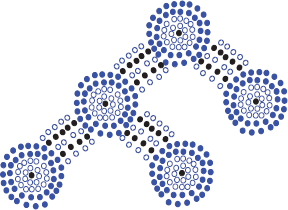Chapter 7. Trees

Contents
7.1 General Trees | 268 |
7.1.1 Tree Definitions and Properties | 269 |
7.1.2 Tree Functions | 272 |
7.1.3 A C++ Tree Interface | 273 |
7.1.4 A Linked Structure for General Trees | 274 |
7.2 Tree Traversal Algorithms | 275 |
7.2.1 Depth and Height | 275 |
7.2.2 Preorder Traversal | 278 |
7.2.3 Postorder Traversal | 281 |
7.3 Binary Trees | 284 |
7.3.1 The Binary Tree ADT | 285 |
7.3.2 A C++ Binary Tree Interface | 286 |
7.3.3 Properties of Binary Trees | 287 |
7.3.4 A Linked Structure for Binary Trees | 289 |
7.3.5 A Vector-Based Structure for Binary Trees | 295 |
7.3.6 Traversals of a Binary Tree | 297 |
7.3.7 The Template Function Pattern | 303 |
7.3.8 Representing General Trees with Binary Trees | 309 |
7.4 Exercises | 310 |
General Trees
Productivity experts say that breakthroughs come by thinking "nonlinearly." In this chapter, we discuss one of the most important nonlinear data structures in computing—trees. Tree structures are indeed a breakthrough in data organization, for they allow us to implement a host of algorithms much faster than when using linear data structures, such as lists, vectors, and sequences. Trees also provide a natural organization for data, and consequently have become ubiquitous structures in file systems, graphical user interfaces, databases, Web sites, and other computer systems.
It is not always clear what productivity experts mean by "nonlinear" thinking, but when we say that trees are "nonlinear," we are referring to an organizational relationship ...
Get Data Structures and Algorithms in C++, Second Edition now with the O’Reilly learning platform.
O’Reilly members experience books, live events, courses curated by job role, and more from O’Reilly and nearly 200 top publishers.

